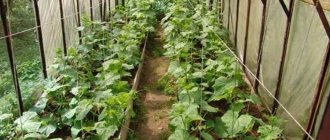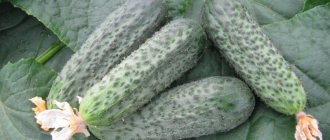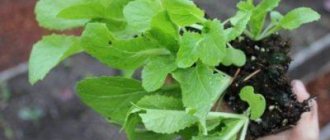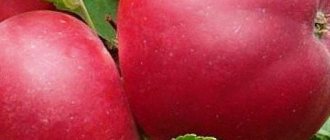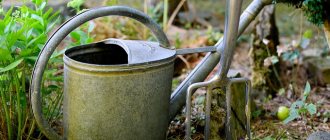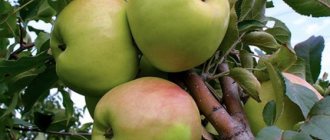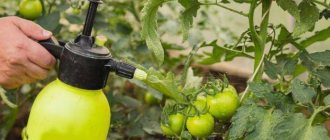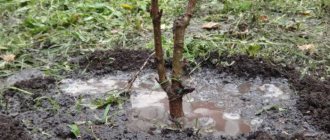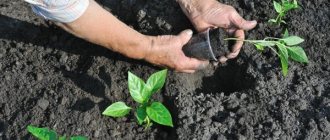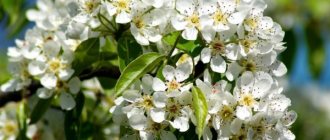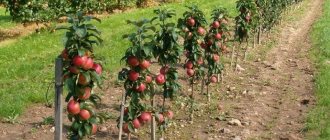Columnar apple tree is a clone of a common variety. Its distinctive feature is the absence of lateral branches. The trunk of the tree is thick, it has many small short branches - up to 15 cm long, on the tops of which there are flower buds. Often branches replace spears and ringlets. The height of the tree usually does not exceed 2 m.
The columnar apple tree begins to bloom and bear fruit at the age of 2–3 years. From the 7th year it brings a stable high yield. It is very easy to collect due to the absence of side branches and the small growth of the tree. This form also makes it easier to water, trim, and treat the apple tree with special means.
Columnar apple trees have appeared recently. In 1964, an unusual branch with a lot of foliage and apples was found on an old McIntosh tree. This mutation became the basis for the creation of a columnar apple tree.
When is the best time to plant columnar apple trees?
The main factor influencing the planting of this variety of fruit trees is optimal weather conditions.
Experienced gardeners say that this can be done both in spring and autumn. In the spring, columnar apple tree seedlings should be planted after the soil receives sufficient sunlight and buds begin to appear on the branches. Do not forget about the period of recurrent night frosts , which can negatively affect young plants. The place where the fruit tree will live begins to be prepared in the fall. For this purpose, a hole is dug and the soil is fertilized.
imperative to take into account the air temperature , which should not be lower than +15 degrees. You should also take into account the climatic features of each region of the country. If in the Moscow region and Leningrad region planting can begin in mid-late April, then in the Urals and Siberia it is simply pointless to do this before the second ten days of May.
It is also possible to transplant young trees in the fall. In the Moscow region, this process occurs at the end of September - beginning of October, and in the Urals - in the first month of autumn. The seedling must have time to take root in the open ground. Delay in planting can cause the tree to stop developing and even die . Be sure to find out which varieties of apple trees are suitable for the Moscow region.
If you purchased planting material in a container with a closed root system, you can plant it even in summer.
Characteristics of columnar crops
How to plant a columnar apple tree correctly? First of all, let's find out what this culture is. Trees of this variety have a number of distinctive characteristics, namely:
- plants do not grow more than 3 meters in length;
- as a rule, the width of the central trunk reaches a maximum of 50 cm;
- each tree is a trunk with short fruit-bearing branches growing at an angle;
- if pruning is not carried out regularly, then eventually the grown tree will resemble a poplar;
- the root system of a columnar crop is very compact, thanks to which the gardener has the opportunity to plant trees densely;
- With properly organized care, up to 12 kg of delicious fruit can be removed from one dwarf tree.
It is worth noting that the columnar culture has one significant drawback: this variety has a relatively short fruiting period. If you plant the trees correctly in the spring, they will bear their first harvest that same year.
As a rule, with proper care, this crop will delight you with abundant fruiting up to 8 years. Then the number of fruits will gradually decrease.
Despite the fact that columnar varieties are capable of producing fruits for 15 years, the peak of abundant fruiting occurs only in the first 8 years. This means that after 10 years, it is necessary to take care of replacing the plant.
It will be useful to know:
1
How to preserve seedlings purchased in the fall until planting in the spring: we store them at home and outside. There are times when the planned autumn planting of seedlings is impossible due to some...
More details
Transplanting an apple tree: timing, rules and features of care An apple tree is an unpretentious fruit tree that does not need special ...
More details
How to properly prepare the soil and planting hole for an apple tree To get a healthy plant and a good harvest, you need to take care of the tree...
More details
Possible diseases and pests
Columnar apple trees are affected by the same insects and diseases as regular varieties. Namely:
- leaf rollers;
- red tick;
- moth: apple, fruit, rowan;
- aphid;
- codling moth;
- scale insect;
- weevil;
- witch's broom;
- powdery mildew;
- scab;
- fruit rot, etc.
To treat trees and for preventive purposes, biofungicides are used, as well as copper sulfate and Bordeaux mixture.
Determining a favorable place
When choosing the most favorable place to locate a columnar apple tree seedling, remember that this area should be maximally protected from strong winds and drafts .
At the same time, it must receive a sufficient amount of sunlight. The best option would be to plant along the fence or near country houses. An apple orchard of dwarf varieties can easily be organized in a greenhouse.
Is it possible to plant columnar apple trees of different varieties side by side?
When planting a large number of seedlings, the timing of maturation plays a major role. It is this criterion that you should pay attention to if you are going to place different varieties of columnar apple trees nearby.
The landing pattern should be as follows:
- summer group;
- autumn group;
- late group.
What to plant next to a columnar apple tree
The columnar apple tree is a very friendly neighbor. Its compact crown allows you to plant other fruit trees next to it. Just don’t get too carried away with compaction. The minimum distance between trees should be 40 cm. This is necessary for uniform access to the sun's rays for all “tenants” of the garden.
Should I plant one apple tree?
It is not recommended to plant this type of apple tree one at a time. At least for aesthetic reasons. A lonely tree with a very specific crown will look extremely strange on your site.
The exception is the Moscow Necklace variety.
Why is it worth growing a columnar crop?
Is it worth planting columnar apple trees? Definitely worth it! And to prove it, we will give you the advantages that this type has:
- high yield;
- compactness of the plant;
- ease of harvesting;
- such a garden beauty takes up minimal space;
- Pests and diseases are not dangerous for this apple tree.
Of course, the crop also has a number of disadvantages that can be easily eliminated, such as a weak root system, the price of planting material and constant care, and sometimes it happens that the tree does not bear fruit. True, in this case the problem should be sought in the organization of care or the plant is not a self-fertile species.
You can fix the problem in the following way: plant and grow another type of columnar apple tree next door. But, even if we take into account all these disadvantages, the columnar apple tree is still endowed with many advantages and has good survival rate, which makes it in demand everywhere.
Pit preparation
Depending on the number of seedlings chosen, it is necessary to clearly understand how to prepare the holes for planting. This happens as follows:
- For an entire orchard, holes should be prepared using the trench method. In this case, the dimensions will be as follows - width up to 45 cm, and depth up to 50 cm;
- for a small number of young trees, separate planting pits are better suited;
- the size must correspond to the root system of the planting material - diameter at least 1 m, depth up to 90 cm.
It is not recommended to apply full mineral fertilizer to planting holes, because a weak root system is not able to absorb large amounts of nutrients, which will negatively affect the development of the tree.
Carrying out pre-landing activities
Conditions
If you have where to plant, what to plant and who to plant, you can begin this responsible event.
The characteristics of your place of residence should tell you both the varieties and the places where the columnar apple tree will be planted. This may be problematic for growing such apple trees .
Don't forget about the possibility of planting a columnar apple tree in a greenhouse . The size of such apple trees allows you to have a mini-garden in a greenhouse.
When to plant columnar apple trees
Plant a columnar apple tree in favorable weather conditions .
They are:
- Like spring. This is what experts prefer: Before buds begin to bloom (see your region).
- But the soil is already warmed up . And this is the second half of April.
- When leaves fall.
Seedling storage
Columnar apple trees.
Planting and care. Don't let the roots dry out . It’s better to dig it in for a while and water it. If you brought it with a closed root system, water it after 2-3 days.
Prepare wet sawdust and place the seedlings in it. Moisturize periodically.
Planting plan
This must be done in accordance with the recommendations of specialists and gardeners' advice. Consider the characteristics of the variety and the rootstock on which the seedlings are grafted.
And realize your ideas and wishes .
Determining a favorable place
It is advised to protect the area from strong winds and drafts. But under the sun. Not in the shade.
I think you've come across such advice. On your own site, this is possible when planting near buildings and fences .
How about trying to do this for a farmer’s industrial garden?
Pit preparation
You can prepare for planting:
- Trenches for several trees on a site or many seedlings when planting a garden. Its dimensions: width and depth of 45-50 cm.
- Planting pits for a small number of seedlings or separately located planting sites.
- Prepare them in advance at least 15-20 days before planting. Or better yet, within a month or a month and a half.
- Their size must correspond to the root system of the seedlings. As a rule, the depth is 80-90 cm, and the diameter is at least 1 m.
Advice! Add mineral and organic fertilizers to the pits: ash, potassium, superphosphate, humus, peat.
Root treatment
Before planting, place in a container of warm water.
You can add growth stimulants . About 12-15 o'clock. Prepare a “chatterbox” from clay. Immediately before planting, dip the roots in it.
Description of the landing process
To successfully transfer the seedling, it is recommended to follow clear step-by-step instructions:
- A fertile layer of soil is poured into the hole.
- The planting material is lowered into the hole so that the upper line of root growth rises slightly above the ground surface.
- The roots are straightened and covered with infertile soil left over from preparing the hole.
- The soil is pressed and filled with 2 buckets of water.
- As soon as the moisture completely goes into the ground, the space around the trunk is covered with peat, shavings or grass.
- For greater stability, the young plant is tied to a peg.
Features of reproduction
Breeding of columnar apple trees is carried out by grafting varietal cuttings using the most suitable rootstock.
Also, propagation of these varieties is permissible using air layering. For this purpose, in the spring, a cutting as thick as a pencil is selected and a 5 mm incision is made at its base, after which a piece of cloth soaked in a growth stimulator is applied to it. The fabric is covered with wet peat, and on top - with a black plastic bag. The structure is fixed to prevent air from entering. In autumn, roots form at the cut site, after which the branch is separated from the mother tree and transferred to the ground. In order for a garden of columnar apple trees to be healthy and bear fruit abundantly, experts recommend purchasing seedlings from nurseries rather than growing them yourself.
Features of planting columnar apple tree seedlings
Depending on what soil predominates in your garden plot, it is necessary to adjust the planting process itself.
In clay soil
If you own a garden with clay soils, then the planting hole for the seedling will have to be made deeper - perhaps even up to one and a half meters. Next, a drainage cushion is created from sand, crushed stone or broken brick. You can also use tin cans or plastic bottles. All this is done to ensure that there is no harmful stagnation of water around the root system.
In sandy soil
Sandy soils are characterized by a high level of water permeability. Loss of life-giving moisture is also dangerous for young trees. When preparing the holes, you should fill them with silt or clay. This will help create an additional waterproofing effect.
At high groundwater levels
When planting columnar apple trees, the trees should not be allowed to fall into soil with a high groundwater level. The minimum mark should be at a depth of 2 m. If there is such a problem at your summer cottage, then the planting material should be planted on bulk hills or earthen ramparts... and take care to equip the drainage system on the site.
At the place of vaccination
Be sure to pay attention to where the vaccination is located. And when transferring the seedling into the soil, make sure that the scion is at a height of 4–6 cm above the level of the near-root hole. Even after the soil settles.
Planting step by step instructions
In order not to wonder in the future why columnar apple trees do not bear fruit, you should approach the planting process very responsibly. So, the apple tree planting scheme:
- A month before planting the crop, you should dig up the area and fertilize it with organic matter.
- Two weeks before planting, a planting hole is formed, 80 cm deep and 60 cm wide.
- In the finished planting hole, place a 5 cm layer of sand or gravel on the bottom, which will serve as drainage.
- Next, take a bucket of fertile soil and rotted humus, mix and add 100 grams each. dolomite flour, potash fertilizers, wood ash and superphosphate. Pour the resulting mixture into the planting hole, then pour it generously with two buckets of water and leave it for two weeks.
- In two weeks we will begin the final landing stage. We install a wooden slat in the center of the hole, and then place a seedling of a columnar apple tree, straighten the roots and sprinkle soil on top, and then fill it with two more buckets of warm and settled water.
- Next, after the water is completely absorbed, the tree trunk circle should be mulched and the seedling should be tied to the rail with twine.
Important: when transporting planting material, make sure that the root system does not dry out. The best option would be to wrap the rhizome with a damp cloth.
It is worth noting that planting and caring for columnar apple trees is not labor-intensive; the main thing is to follow the simplest planting rules and adhere to the simplest recommendations.
Differences by season
For a better result of planting columnar apple trees, it is necessary to follow the rules accompanying the planting season.
Planting in spring
Considering the low frost resistance of these trees, it is recommended to transfer young trees to open ground in the spring.
Planting scheme
Recommended scheme for planting young columnar apple trees in the spring:
- Prepare the holes in the fall, this will help the soil to stand and the fertilizers to dissolve.
- When planting several trees, place them at a distance of 50 cm from each other, and leave a gap of 1 m between the rows.
- Make the hole a standard size (45 by 50 cm), taking into account the size of the root system.
- Make sure there is organic fertilizer in the pit, which will become a source of nutrients for the young plant.
Fertilizer application
Fill the planting hole with:
- up to 500 g of ash;
- 80 g potassium;
- 100 g superphosphate;
- 5 kg of organic fertilizers.
Planting an apple tree in autumn
Based on the conditions of your region, be guided by the timing of disembarkation. If you do not have time to do it on time, then it is better to postpone this procedure, and bury the seedling in a suitable place until spring and insulate it for the winter.
Scheme
The recommended planting scheme in autumn is no different from spring, except for the timing.
Fertilizer application
It is not recommended to apply any fertilizers when planting young material in open ground. It is better to wait until spring for this action. Watering should also be reduced by at least half.
Autumn care, preparation for winter
The most important stage in caring for any apple tree is, of course, harvesting.
By the way, the most pleasant. So many positive emotions. The anxiety and worries about the harvest are behind us. And here in front of you are boxes of collected apples. Think further. How to preserve them longer. Or maybe it will be implemented.
The main goal of autumn events is to prepare the tree for winter:
- Feed well.
- Make charging waterings.
- Treat against diseases and pests.
- Perform only sanitary pruning.
- The main concern is to protect against freezing and rodent pests. Although they are affectionately called - bunnies, mice.
In August-September
Stop fertilizing with fertilizers containing nitrogen. Trees are in great need of potassium fertilizers . Pay attention to the tips of the shoots and cut off the top 3-4 leaves by two-thirds.
Feeding time
In August–September, potassium fertilizers. They will help you survive the winter better.
Watering
Abundant watering in winter can prevent the roots from freezing .
Watering is required after each transplant.
Is it necessary to cover a mature tree?
Who is asking this question? Gardeners in regions with harsh climates (frost, snowfall) know that this is not even in doubt. It must be done carefully. And here the question arises.
Frost protection
- Bury the trunks.
- Cover with spruce branches, shavings and sawdust.
- Wrap it with modern insulating materials.
- Cover with snow if available and trample down.
- Protect not only from frost, but also from rodents.
How to care for a good harvest?
- One can only partially agree with this formulation of the question. And why? Yes, because every gardener knows for sure - to grow crops all season long. And every year.
- And what you read above should give you confidence in the need to follow these recommendations.
- And caring for a columnar apple tree in the fall is an integral part of the whole complex. And like each of them, very important.
Caring for a columnar apple tree after planting
Post-planting care for columnar apple tree seedlings consists of:
- watering;
- fertilizing;
- trimmings;
- regulation of the load on a young plant during the flowering period;
- timely harvesting;
- protection in winter.
Regulating the number of ovaries on trees helps control the quality of the crop. Overloading the tree contributes to the degeneration of the variety and the crushing of fruits.
We must not forget about mulching and tinning. The first is done by placing hay or sawdust around the trunk of a young tree. This method of care helps protect the planting from frost. It is recommended to use spruce branches of coniferous trees as a surface “blanket”. And by grassing we mean sowing the free space around the tree with herbs or cereal crops.
If the forecast for the winter is extremely disappointing with regard to catastrophically low temperatures, then it is recommended to carry out hilling, which will help protect the trees from freezing and attacks by rodents.
To water columnar apple trees, you need to set up a drip irrigation system. If you do not have such an opportunity, then carry out manual irrigation yourself every 3-5 days.
One of the most important processes in caring for seedlings is pruning, which is carried out in the first year after planting in the spring. Young side shoots are removed, leaving only two eyes. In the fall they will grow into two strong branches that must be removed the following spring. In the third year, the formed fruitful branch will give you a full harvest, after which it is cut off.
Proper care allows you to get a high-quality harvest from trees even before they are 5–6 years old. After reaching this period, fruiting rates begin to decline, which requires measures to rejuvenate them.
Systematic soil fertilization plays an important role for the growth of young apple trees.
Urea can be used as a top dressing. Additional nutrition procedures should be carried out correctly from March to June. In addition to urea, slurry or processed chicken manure is often used. It is recommended to fertilize young trees at least 3 times per season. Periodicity:
- in the spring they add organic matter under the roots;
- in mid-June, complex supplements containing nitrogen, potassium and phosphorus are required;
- In August, potassium-containing fertilizers are needed, but nitrogen and phosphorus must already be excluded.
general characteristics
The very type of this crop arose by accident, but then gained enormous popularity among gardeners all over the world, since the characteristics of the varieties of columnar apple trees are very high. I especially like the shape of this tree, which is compact and doesn’t take up much space.
How did the columnar apple tree originate?
- This tree is a clone of an ordinary apple tree, which was bred by chance. A special feature is the absence of side shoots.
- In Canada (British Columbia), in the small village of Kelowna in 1964, on an ordinary apple tree (McIntosh variety), which was already 50 years old, a branch of unusual structure was discovered.
- Its shape really surprised plant growers: there were no side shoots, and the skeletal branch was densely covered with foliage and had a very large number of fruits.
- As a result, breeders used this mutation to advantage, and developed a new type of apple tree, which was later called Columnar.
- The first specimens were presented in 1976, and scientists from England (Kent County) were engaged in breeding work. Also in other countries they began to actively improve this type of apple tree.
Morphological features
Currently, about 100 varieties and varieties of columnar apple trees have been officially recorded. All of them are divided into 3 main groups: dwarf - with a height of up to several meters; semi-dwarf - up to z - m; tall - more than 3 m. The tissues of this crop contain a special gene - Co. Thanks to it, the branches are located in relation to the main trunk at an acute angle, literally adjacent to it. As a result, the appearance of the crown is very similar to the appearance of a pyramidal poplar. The central trunk is very strong and dense, covered with small shoots and flower buds that form on the apical part. The branches that are located on the sides are not as dense and not as well formed as those of ordinary apple trees. Most of them are represented by fruits, spears or ringlets. The shoots are quite small in size, and the internodes are shorter. The tallest varieties branch 3–4 times more, and semi-dwarf varieties are 1.5–3 times more active than dwarf varieties. When the tree is 3-4 years old, growth slows down or stops altogether.
This process also occurs when the apical bud is damaged (the most important place in a columnar apple tree!). Then lateral branching is activated. Flowering and then fruiting first appear 2 - 3 years after planting the seedling
Further, the yield level increases every year. At 7-8 years it stops at a certain level and continues, gradually declining, until 15-20 years. Then the apple tree dries out and needs to be renewed and replaced with another specimen.
Advantages
There are many positive qualities that allow you to grow this tree in your summer cottage. Let us briefly list the main ones.
- Pruning is not necessary, but the apical growth bud is especially important.
- Its small size allows you to plant several varieties of columnar apple trees in a small area. This is very convenient if the dacha plot is compact.
- Fruiting occurs quite quickly, already 2–3 years after planting. At the same time, the yield is much higher than that of a regular apple tree - you can get 5 - 16 kg from one copy.
- It is very convenient to care for such a small tree: water, fertilize, carry out preventive measures to combat harmful insects (spraying the crown). It is also very convenient to harvest.
Flaws
There are only a few disadvantages to growing, which are not always mentioned when purchasing from a nursery.
- The cost of such an apple tree is much higher than the price of seedlings of an ordinary fruit tree.
- The life of columnar apple trees is quite short-lived - a maximum of 20 years.
With all comparative characteristics, the advantages are significantly greater. Therefore, every gardener should definitely try to grow this crop on his plot and get an excellent harvest of apples.
What trees and plants can apple trees be planted with?
Pear. The distance between pear trees should be about 5-6 meters. Pear seedlings should be planted according to the 2*3 m pattern. The distance between the pear and apple tree should be 4-5 meters. If the varieties are dwarf, the distance is reduced to 3-4 meters.
Pear
At what distance should fruit trees be planted from each other?
In the free space between the apple and pear trees, for the first 3 years you can plant low plants: tomatoes, zucchini, radishes, carrots, eggplants, beets, potatoes, radishes, onions, peppers, beans, spinach. It is not recommended to plant berries.
After planting, young apple and pear trees are watered every 7 days for a month, then every 20 days for another 3-4 months.
Cherry. Cherry trees are recommended to be planted in the fall, but biennial plants can be planted in the spring.
If the cherry variety is self-pollinating, you can plant the plants at a distance of 3 meters from each other. If the variety is cross-pollinated (the plant has both male and female flowers), plant at least 4 trees.
Dwarf and semi-dwarf cherries are planted according to the scheme 2 * 2.5 m, tall ones - 2.5 * 3 m.
Important! Apple and cherry trees get along well only if they do not grow in close proximity to each other. Otherwise, the apple tree may suffer.
The distance between the apple and cherry trees should be 10 meters, provided that both trees are short. If the trees are tall, then at least 15 meters. Some varieties of apple trees coexist perfectly with cherries at a distance of 5 meters. Cherry prefers the same soil and growing conditions as apple trees. However, the apple tree loves its coniferous neighbors, but the cherry tree cannot stand it. Unlike the apple tree, which can grow well in the shade, the cherry tree does not like dark places.
Cherry does not tolerate proximity to strawberries, blueberries, tomatoes, peppers, raspberries, black currants, and eggplants. It is also not recommended to plant cherries with trees that have a powerful root system (spruce, oak, poplar, linden, pine, birch). But it gets along well with plums, honeysuckle and cherries.
Apricot. The southern fruit does not particularly like its neighbors; the apple tree should be planted at least 10 meters from it. Almost no one likes apricots. This plant needs to be planted separately from all others.
Apricot
Apricot trees are planted according to the 3*5 or 5*5 m pattern. The interval between trees is 3-4 meters. The distance from fences or buildings to the apricot is at least 3 meters.
Plum. Like the apple tree, the plum tree loves sunny places, soil without close groundwater. The best planting time is spring.
It is recommended to maintain a distance of 3 meters between medium-sized plums, and 4-5 meters between tall ones. Plums are planted according to the 2 * 4.5 m pattern.
The distance between the plum and apple tree should be at least 10 meters. These plants will not make good neighbors. It also cannot tolerate plums in proximity to pears, black currants, and raspberries. But black elderberry and maple will get along well with it and even increase the harvest.
Black elderberry
Many people plant juniper under the apple tree and near it, believing that this coniferous plant will decorate the garden and bring benefits. The apple tree lives really well in proximity to conifers, but juniper - both common and creeping - can infect fruit trees with rust, which is difficult to get rid of. The juniper dries out, turns brown or becomes lighter, and orange and red spots appear on the apple tree, shoots, fruits, leaves fall off, and in advanced cases, the bark cracks and dries out. But despite all this, juniper cannot be the cause of mass disease and death of fruit plants.
Main varieties with photographs and descriptions
The division of varieties is carried out depending on their growth, namely, they are divided into vigorous, medium-sized (semi-dwarf), and also dwarf. They are also divided according to the time of fruit ripening into late (winter), mid-season (autumn) and early (summer). Below are varieties divided by ripening time.
Summer varieties
On these plants, ripe apples can be harvested from the last days of July to the first days of September. Such fruits are eaten fresh or used to make preserves, jams, compotes, etc. The shelf life of such apples is relatively short.
The most popular varieties:
Nectar
This semi-dwarf variety is characterized by high yield and resistance to frost, diseases and harmful insects. Yellowish-white apples have a fairly thick skin, as well as juicy and grainy flesh with a distinct honey taste. On average, each apple weighs 100–250 grams. Plant height can vary from 200 to 250 centimeters.
The president
This semi-dwarf compact variety is characterized by high yield and resistance to frost, harmful insects and diseases. The fruits are very fragrant, pale yellow or pale green, in some cases they have a slight light pink blush. On average, apples weigh from 150 to 200 grams. The fine-grained pulp is juicy and tender.
Vasyugan
This productive variety is resistant to frost, harmful insects and diseases. The shape of the red-striped fragrant fruit is conical, the taste of the pulp is sourish-sweet, and it has clearly visible subcutaneous points. The cream-colored flesh is distinguished by its softness and juiciness. On average, the weight of the fruit is 140–200 grams.
Dialogue
The medium-sized variety is characterized by productivity and resistance to frost, pests and diseases. The deep yellow apples are not very large in size, but they are quite juicy. The shape of apples is flat.
Ostankino
The medium-sized variety is resistant to harmful insects and diseases. The fragrant, sour-sweet fruits have a light green color with a blush that has a fuzzy, blurry shape. Juicy apples can weigh from 100 to 220 grams.
Also quite popular among gardeners are such varieties as: Chervonets, Luch, Ideal, Raika, Flamingo, Gala, Cheremosh, Iksha, Green Noise, etc.
Autumn varieties
Fruit ripening on plants of these varieties occurs throughout the autumn period. They are eaten fresh or made into various preparations for the winter. Such apples are stored for a relatively short time (maximum until January). Popular varieties:
Malyukha
This dwarf variety is one of those that have the highest taste. The truncated-conical shape of dessert apples is large in size. They are painted orange-yellow or deep yellow and weigh from 150 to 250 grams. The durable, glossy skin is quite thin, and the yellow, fragrant flesh is fine-grained. This variety is high-yielding and early-bearing.
Gin
The variety is characterized by productivity and resistance to frost. The rich red fruits can weigh 80–200 grams. The sweet and sour pulp is firm and juicy. Apples can last until January.
Triumph
Medium-sized variety. The apples have a rich dark red color and have a striped blush on their surface. The shiny peel is quite dense. Snow-white crispy fine-grained pulp. It has a dessert sweet taste with a slight sourness. On average, apples weigh 100–150 grams.
Arbat
The variety is characterized by high yield and resistance to frost, harmful insects and diseases. The fruits ripen in the last days of September or the first days of November. Rich cherry color, medium-sized glossy apples with sour-sweet juicy flesh. The average fruit weight is from 100 to 120 grams.
Iedzen
This vigorous variety is resistant to scab and is winter-hardy. There are red streaks on the surface of yellow apples. The average fruit weight is 150 grams. The fine-grained, dense yellowish-green pulp has a sweet and sour taste. The taste is high.
Also quite popular are varieties such as: Kumir, Ladoga, Titania, Teleimon, Melba, etc.
Winter varieties
The ripening of apples of these varieties occurs in mid-autumn. They can last until spring. The following varieties are popular:
Amber necklace (amber)
The medium-sized variety is characterized by productivity and resistance to frost. Large greenish-yellow apples have a blush. The fine-grained, fragrant pulp is juicy and sour-sweet.
Currency
A medium-sized, early-fruiting variety, characterized by high yield, resistance to frost and scab. The fruits are large (weighing approximately 200 grams) and have a rich yellow color with a red side. The snow-white, sweet, juicy pulp is quite fragrant.
Moscow necklace
This self-sterile variety is characterized by high yield and resistance to frost, harmful insects and diseases. The fruits are quite large and dark red. The peel is dense. The sweet, juicy pulp has a slight sourness. On average, apples weigh about 170 grams.
Bolero
The fruits are large and their average weight is about 200 grams. The firm white flesh is juicy.
Pruning in spring and autumn
A columnar apple tree needs to be pruned regularly to ensure that the top remains intact and develops normally. If it freezes or is damaged, side shoots will begin to develop, and the apple tree will turn from a columnar one into a regular one.
You need to form a columnar apple tree in several stages:
- A year after planting, all side shoots are removed. Only the top and two buds are left untouched.
- Next year, even the remaining buds will form young shoots. The branch that will grow vertically upward is shortened again, leaving only two buds. The second branch, which is located more horizontally, remains untouched, since it is on it that the crop will form.
- In the new season, the horizontal branch from which the harvest was harvested last year is removed.
The crown shoot is pruned only if it shows severe symptoms of frostbite. However, try to do everything possible to prevent the top from freezing, since the appearance and productivity of the tree will depend on it.
Note: The best time to prune an apple tree to shape it is considered to be the end of winter. However, the procedure can also be carried out in spring and autumn.
The pruning scheme for young and mature columnar apple trees largely depends on the season. For example, in the spring, pruning is necessary in order to stimulate the growth of the tree and form a crown of a certain shape. The procedure is carried out in the middle or end of March, before the kidneys begin to awaken. In this case, all shoots are shortened, except for the central one, leaving only 4-5 buds on them. It is also necessary to remove all frozen parts of the plant (Figure 4).
Figure 4. Scheme of formative pruning of a plant
In the fall, it is also necessary to thin out the apple tree. This procedure will help the tree endure winter more easily. Pruning is carried out only after the leaves have fallen from the branches and the sap flow in the shoots has slowed down. First of all, remove all dry and damaged branches, then cut out all twisted shoots. Also, if desired, you can remove those branches that produced a harvest this year, since they will no longer bear fruit in the new season. However, experienced gardeners still recommend postponing this stage until spring.
